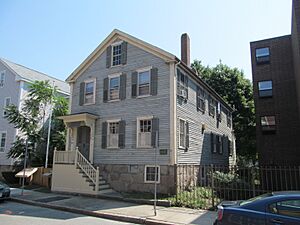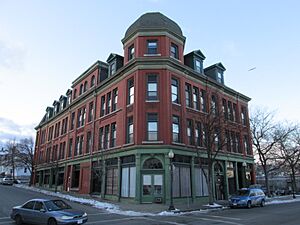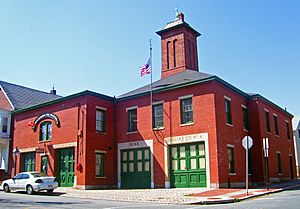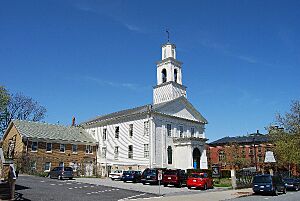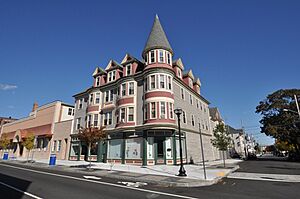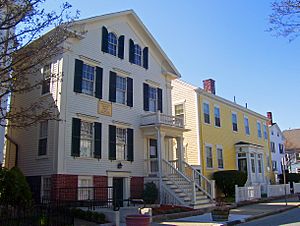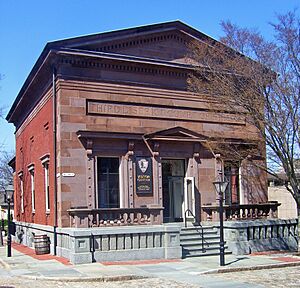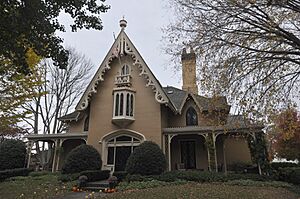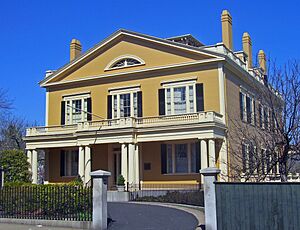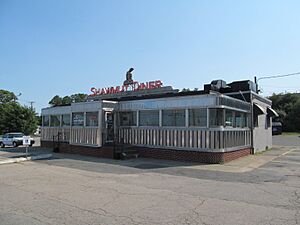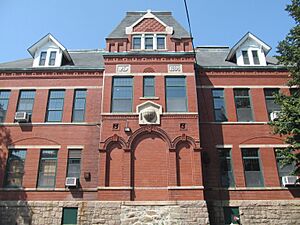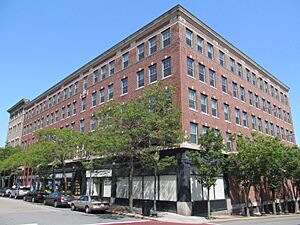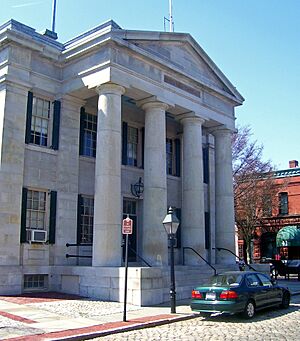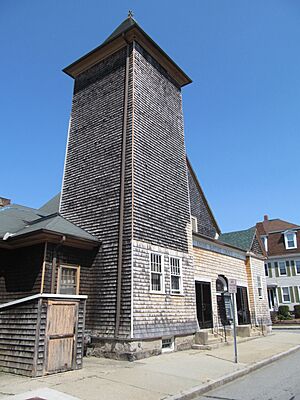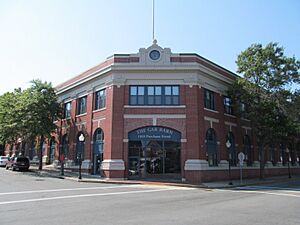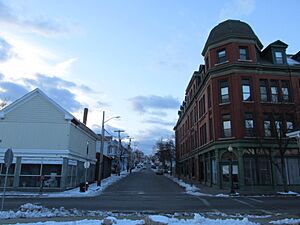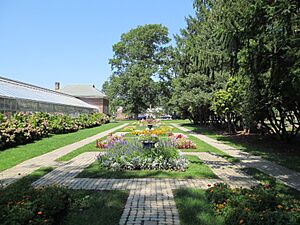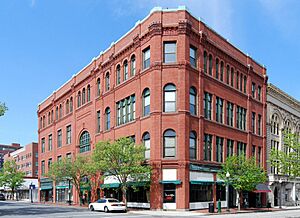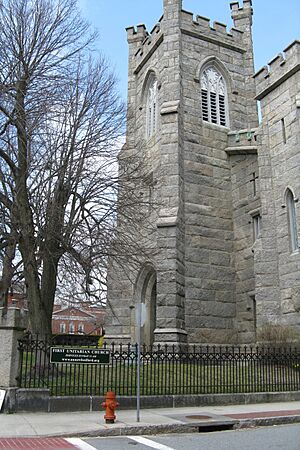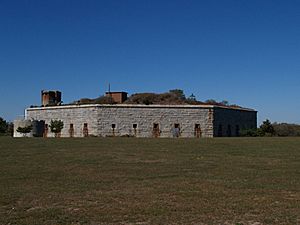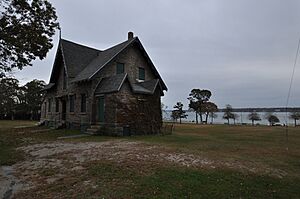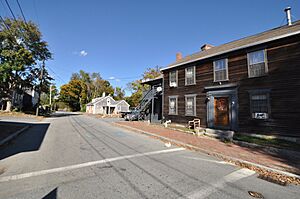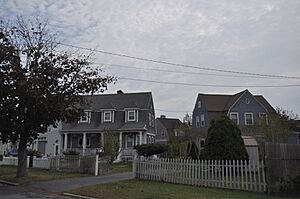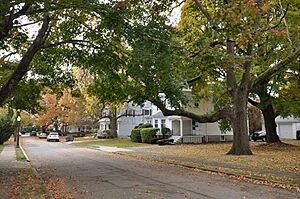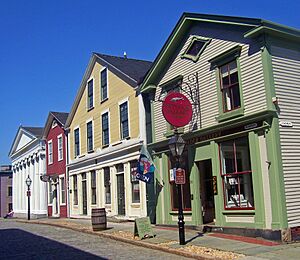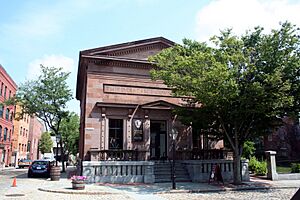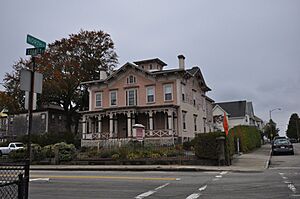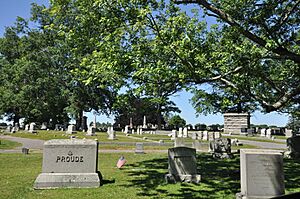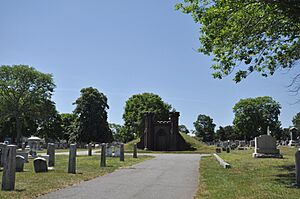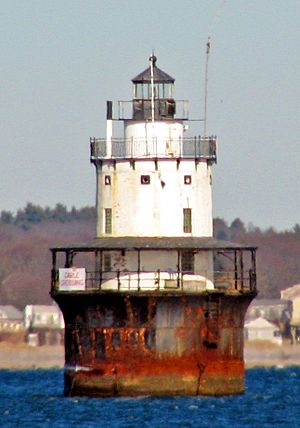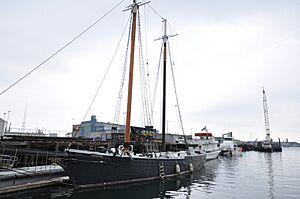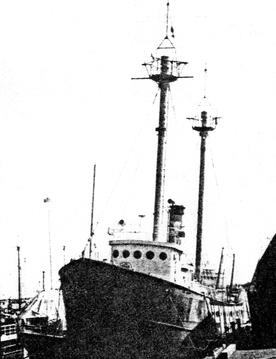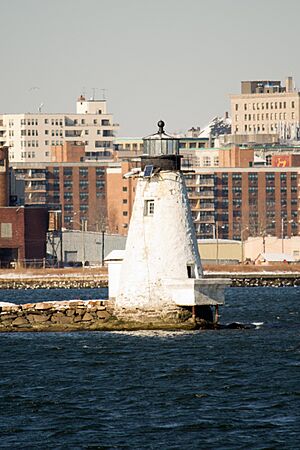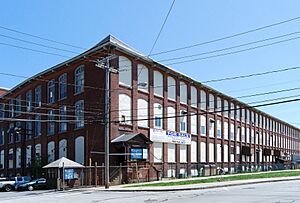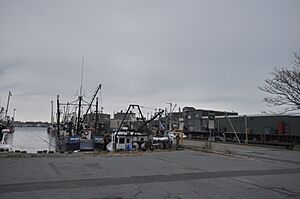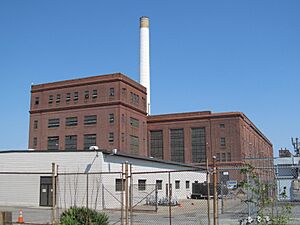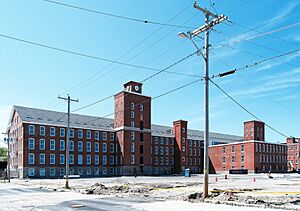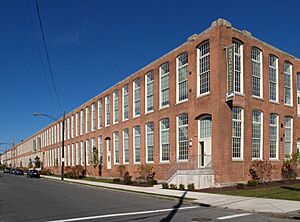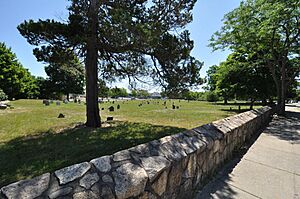National Register of Historic Places listings in New Bedford, Massachusetts facts for kids
New Bedford, Massachusetts, is a city with a rich history, especially known for its whaling industry in the 1800s. Many buildings, parks, and even a ship in New Bedford are so important that they are listed on the National Register of Historic Places. This special list helps protect places that are significant to American history, architecture, archaeology, engineering, or culture. Let's explore some of these amazing spots!
Contents
- Historic Buildings and Homes in New Bedford
- Sgt. William H. Carney House
- Dawson Building
- Fire Station No. 4
- First Baptist Church
- Hotel Waverly
- Nathan and Mary Johnson Properties
- Old Third District Courthouse
- William J. Rotch Gothic Cottage
- William Rotch Jr. House (Rotch-Jones-Duff House and Garden Museum)
- Shawmut Diner
- Thompson Street School
- Times and Olympia Buildings
- U.S. Customhouse
- Union Baptist Church
- Union Street Railway Carbarn, Repair Shop
- Historic Districts and Parks
- Acushnet Heights Historic District
- Buttonwood Park Historic District
- Central New Bedford Historic District
- County Street Historic District
- Fort Taber District
- Hazelwood Park
- Head of the River Historic District
- Howland Mill Village Historic District
- Moreland Terrace Historic District
- New Bedford Historic District
- New Bedford Whaling National Historical Park
- North Bedford Historic District
- Oak Grove Cemetery
- Rural Cemetery and Friends Cemetery
- Historic Vessels and Lighthouses
- Industrial History
- Cemeteries
- Former listings
Historic Buildings and Homes in New Bedford
New Bedford has many old buildings that tell stories of the past. These places show us how people lived, worked, and built their communities long ago.
Sgt. William H. Carney House
The Sgt. William H. Carney House at 128 Mill Street is a very important home.
It belonged to William Harvey Carney, an American soldier who fought bravely in the American Civil War. He was the first African American to be awarded the Medal of Honor, the highest military award in the United States, for his courage during the Battle of Fort Wagner. His house reminds us of his incredible bravery and his fight for freedom.
Dawson Building
The Dawson Building is located at 1851 Purchase Street.
This building is a historic landmark, showing the kind of architecture that was popular when it was built. It's a great example of how buildings from the past can still be important parts of our cities today.
Fire Station No. 4
At 79 South 6th Street, you'll find Fire Station No. 4.
Built in 1867, this building was once the oldest fire station still in use in Massachusetts! Today, it's home to the New Bedford Fire Museum. Here, you can learn all about the history of firefighting in the city and see old fire trucks and equipment.
First Baptist Church
The First Baptist Church stands at 149 William Street.
Churches are often important community centers and architectural landmarks. This church has been a part of New Bedford's history for many years, serving its community and showcasing beautiful design.
Hotel Waverly
The Hotel Waverly is located at 1162-1166 Acushnet Avenue.
This building once served as a hotel, providing lodging for travelers and visitors to New Bedford. Its architecture reflects the style of the time it was built, giving us a glimpse into the city's past.
Nathan and Mary Johnson Properties
The Nathan and Mary Johnson Properties at 17-19 and 21 7th Street are a very special place.
This was the home and meeting place of Nathan Johnson and Mary Johnson, an African-American couple who were strong supporters of ending slavery. They were part of the Underground Railroad, a secret network that helped enslaved people escape to freedom. When Frederick Douglass, a famous abolitionist, escaped from slavery, the Johnsons welcomed him into their home. This site is a National Historic Landmark, meaning it's recognized as one of the most important historic places in the entire country.
Old Third District Courthouse
The Old Third District Courthouse is found at the corner of 2nd and William Streets.
This building once served as a courthouse, where legal cases were heard. Today, it houses the New Bedford Whaling National Historical Park Visitor Center, where you can start your journey to learn about the city's whaling history.
William J. Rotch Gothic Cottage
The William J. Rotch Gothic Cottage at 19 Irving Street is a unique house.
It's known for its "Gothic Cottage" style, which was a popular architectural design in the mid-1800s. It looks a bit like a small castle or a charming storybook house. This home is also a National Historic Landmark.
William Rotch Jr. House (Rotch-Jones-Duff House and Garden Museum)
The William Rotch Jr. House, located at 396 County Street, is a grand home.
It was designed by Richard Upjohn, a famous architect, for a very important whaling family. Today, it's known as the Rotch-Jones-Duff House and Garden Museum. You can visit and see how wealthy families lived in New Bedford during the height of the whaling industry, and explore its beautiful gardens. This is also a National Historic Landmark.
Shawmut Diner
The Shawmut Diner at 943 Shawmut Avenue is a classic American diner.
Diners are a unique part of American culture, often built with shiny metal and bright colors. This diner is a great example of these roadside restaurants that became popular in the 20th century.
Thompson Street School
The Thompson Street School is located at 58 Crapo Street.
Old school buildings like this one are important because they show us how education has changed over time and how communities invested in their children's futures.
Times and Olympia Buildings
The Times and Olympia Buildings are found at 908-912 and 880-898 Purchase Street.
These buildings represent the commercial and entertainment history of New Bedford. They likely housed businesses, offices, or even theaters in their prime.
U.S. Customhouse
The U.S. Customhouse is at the southwestern corner of 2nd and Williams Streets.
This building is incredibly important because it's the oldest U.S. Customs facility that has been used continuously! It was designed by Robert Mills, a famous architect, in the Greek Revival style. Customs houses were vital for collecting taxes on goods coming into the port, showing New Bedford's importance as a trading city. It is also a National Historic Landmark.
Union Baptist Church
The Union Baptist Church stands at 109 Court Street.
Like other historic churches, it has played a significant role in the spiritual and community life of New Bedford residents for many years.
Union Street Railway Carbarn, Repair Shop
The Union Street Railway Carbarn, Repair Shop is located at 1959 Purchase Street.
This building was once where streetcars (like old-fashioned trolleys) were stored and repaired. It tells us about the history of public transportation in New Bedford and how people used to get around the city.
Historic Districts and Parks
New Bedford also has several historic districts, which are areas with many historic buildings that together tell a story. There are also important parks and natural areas.
Acushnet Heights Historic District
The Acushnet Heights Historic District is a large area roughly bounded by Summer, Weld, Purchase, Pope, County, and Robeson Streets.
This district includes many homes and buildings that show the architectural styles and neighborhood development of New Bedford over time. Walking through it is like taking a step back in history.
Buttonwood Park Historic District
The Buttonwood Park Historic District includes the area around Kempton Street, Rockdale Avenue, Hawthorne Street, and Brownell Avenue.
This district is centered around Buttonwood Park, a beautiful public park designed by Frederick Law Olmsted, who also designed Central Park in New York City. The park and the surrounding neighborhood show how cities planned green spaces and residential areas in the past.
Central New Bedford Historic District
The Central New Bedford Historic District is the heart of the city, roughly bounded by Acushnet Avenue and School, Middle, and 6th Streets.
This area contains many of New Bedford's most important historic buildings, including those related to its whaling and industrial past. It's where much of the city's early business and social life happened.
County Street Historic District
The County Street Historic District is roughly bounded by Acushnet, Page, Middle, and Bedford Streets.
County Street was known for its grand homes and beautiful architecture, especially during New Bedford's wealthy whaling era. This district showcases the elegant residential areas of the city's past.
Fort Taber District
The Fort Taber District is located on Wharf Road within the Fort Rodman Military Reservation.
This area includes Fort Taber, a historic fort built to protect New Bedford's harbor. It played a role in coastal defense, especially during the American Civil War. Today, it's a park where you can explore the old fort and enjoy views of the ocean.
Hazelwood Park
Hazelwood Park is a lovely green space at 597-603 Brock Avenue.
Parks like Hazelwood were created to provide recreation and natural beauty for city residents. It's a place where people can relax, play, and enjoy the outdoors, just as they did many years ago.
Head of the River Historic District
The Head of the River Historic District is found at 2-28 Mill Road and 2-13 Tarkiln Hill Road.
This district extends into the nearby town of Acushnet, Massachusetts. It represents an older, more rural part of the area's history, showing how communities developed along rivers and waterways.
Howland Mill Village Historic District
The Howland Mill Village Historic District is roughly bounded by Bolton, Winsper, Hemlock Streets, and Rockdale Avenue.
This district was a "mill village," meaning it was built to house workers for the nearby textile mills. It shows how industrial growth led to the creation of entire neighborhoods for factory employees.
Moreland Terrace Historic District
The Moreland Terrace Historic District is roughly bounded by Moreland Terrace, Ash, Bedford, and Page Streets.
This residential district showcases the architecture and planning of a specific period in New Bedford's development, with homes that reflect the styles popular at the time.
New Bedford Historic District
The New Bedford Historic District is a very important area, bounded by Front Street on the east, Elm Street on the north, Acushnet Avenue on the west, and Commercial Street on the south.
This district is a National Historic Landmark District, which means it's recognized as one of the most important historic areas in the entire country. It includes many of the buildings connected to New Bedford's famous whaling industry, which made the city one of the wealthiest in the world in the 19th century.
New Bedford Whaling National Historical Park
The New Bedford Whaling National Historical Park is centered around 33 William Street.
This park was created to preserve and interpret the history of whaling and its impact on New Bedford and the nation. It's not just one building, but an area that includes many historic structures and tells the story of the city's past as the world's leading whaling port.
North Bedford Historic District
The North Bedford Historic District is roughly bounded by Summer, Park, Pleasant, and Kempton Streets.
This district offers another look at the residential development of New Bedford, with homes and streetscapes that reflect different periods of the city's growth.
Oak Grove Cemetery
Oak Grove Cemetery is located on Parker Street.
Cemeteries are often historic places because they contain the graves of important people and show the art and design of memorial markers over time. They can also be beautiful, peaceful green spaces.
Rural Cemetery and Friends Cemetery
The Rural Cemetery and Friends Cemetery are located at 149 Dartmouth Street.
Like Oak Grove, these cemeteries are historic sites that tell us about the lives of past residents and the history of burial practices and landscape design.
Historic Vessels and Lighthouses
New Bedford's history is deeply connected to the sea. Several historic vessels and lighthouses are also listed as historic places.
Butler Flats Light
The Butler Flats Light is a lighthouse located in the New Bedford Channel.
Lighthouses are important for guiding ships safely into and out of harbors. This light has stood as a beacon for sailors entering New Bedford for many years.
ERNESTINA (schooner) (formerly Effie M. Morrissey)
The schooner ERNESTINA (originally named Effie M. Morrissey) is a historic ship that was once located at Steamship Wharf.
This ship is a National Historic Landmark because of its long and varied history. It has sailed to the Arctic, served as a fishing vessel, and even carried immigrants. It's a great example of a traditional sailing ship and its importance to maritime history.
Lightship No. 114
Lightship No. 114 was a special kind of ship that served as a floating lighthouse, anchored in places where it was too difficult to build a lighthouse.
This particular lightship was once located at State Pier. Sadly, it was later scrapped, but its listing reminds us of its past role in maritime safety.
Palmer Island Light Station
The Palmer Island Light Station is a lighthouse located in New Bedford Harbor.
This lighthouse is another important navigational aid that has helped guide ships through the busy waters of New Bedford's port for many years.
Industrial History
New Bedford was not only a whaling city but also a major industrial center, especially for textile manufacturing.
Manomet Mills
The Manomet Mills are located at 194-194R and 200 Riverside Avenue.
These mills were part of New Bedford's huge textile industry, where cotton and other materials were turned into fabric. They represent an important era of manufacturing and labor in the city's history.
Merrill's Wharf Historic District
The Merrill's Wharf Historic District is located along MacArthur Drive.
This district includes the Steamship Pier and the Coal Pocket Pier. Wharves and piers were essential for shipping goods and passengers, showing New Bedford's role as a busy port.
New Bedford Gas and Edison Light Complex
The New Bedford Gas and Edison Light Complex is at 180 MacArthur Drive.
This complex was vital for providing gas and electricity to the city, powering homes, businesses, and industries. It shows the development of modern utilities and infrastructure.
Wamsutta Mills
The Wamsutta Mills are a large complex located along Acushnet Avenue, Logan, Wamsutta, and North Front Street.
The Wamsutta Mills were one of the most famous and important textile mills in the United States. They were a huge part of New Bedford's economy and history, employing thousands of people and producing high-quality fabrics.
Whitman Mills
The Whitman Mills are located at 1, 90, and the eastern side of Riverside Avenue, rear 1 and the southern and northern sides of Coffin Avenue, and 10 Manomet Street.
Like Wamsutta, the Whitman Mills were a significant part of New Bedford's textile industry, contributing to the city's industrial power and growth.
Cemeteries
Griffin Street Cemetery
The Griffin Street Cemetery is located at South 2nd and Griffin Streets.
This cemetery is a historic site, offering insights into the lives and burial customs of New Bedford's past residents.
Former listings
Some places that were once on the National Register of Historic Places are no longer listed, often because they were demolished or significantly changed.
Rotch Counting House
The Rotch Counting House was once located at 123 Front Street. It was removed from the list in 1972 because it was demolished to make way for the construction of the JFK Memorial Parkway in downtown New Bedford. A "counting house" was an office where merchants, especially those involved in whaling, managed their business and finances.


